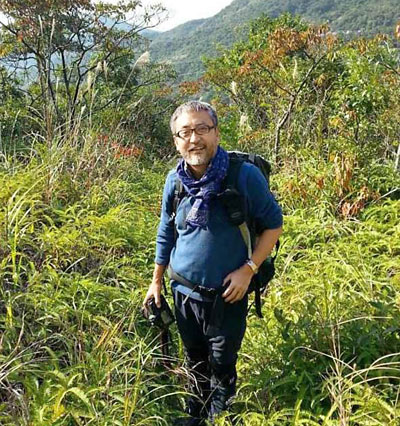|

About the author
Like many migrants, Nan Zhaoxu, a Shanxi native, came to Shenzhen in 1989 with little money. He first worked as an interpreter in a leisure club in Futian District for sixth months. After earning 80,000 yuan from operating a low-budget hotel in Chiwei Village in 2007, he founded his own publishing and documentary production company, Yuezhong Cultural Transmission Co. His books on Shenzhen’s history, such as “The Shenzhen Memory (1949-2009)” and “Behind the Old Files of Shenzhen,” focus on ordinary people’s stories rather than government leaders’ achievements. Nan’s passionate and thoughtful writing combines his acute perceptivity of history, culture and humanity.Cao Zhen
caozhen0806@126.com
U.S. ecologist and conservationist Aldo Leopold famously wrote in his 1949 non-fiction book “A Sand County Almanac”: “For us of the minority, the opportunity to see geese is more important than television, and the chance to find a pasque-flower is a right as inalienable as free speech.” Leopold was expressing a responsible relationship existing between people and the land they inhabit.
Now a similar Chinese-language book has been published, advocating the idea of such a homeland. The book, titled “Notes of Landscape in Shenzhen,” is considered by readers to be a landmark in Shenzhen’s nature-conservation movement. Written by local author and publisher Nan Zhaoxu, it features more than 1,800 photos extolling the beauty of Shenzhen’s wildlife and emphasizing that humans are very much a part of it.
“I want to convey the idea that between ‘home’ and ‘nation,’ there is a ‘homeland’ for every one of us,” Nan told the Shenzhen Daily. “My point is to let readers know that Shenzheners are living in such a beautiful place rich in different species. Please love and protect our homeland.”
In this 222-page paperback, Nan displays the wonders of nature, which can be found not only in the remote corners of the world but also at the foot of field hedges and small hills in rural Shenzhen. With an eye for subtle beauty, Nan visited the city’s coastlines, mountains, rivers and villages more than 350 times from 2004 to 2013 with his friends, recording his observations of rare insects, plants and animals. Renowned places include Qiniang Mountain, Nei Lingding Island, Mangrove Nature Reserve and Baguang Village. Some of the photos in the book were contributed by Nan’s hiking friends.
“In the beginning, I just hiked and photographed for fun but later on I thought I need to write it down. In different seasons and climates, I saw different conditions of wildlife,” said Nan.
When the book was exhibited at the fifth Shenzhen-Hong Kong Bi-City Biennale of Urbanism\Architecture, it attracted attention from Kieran Long, a senior curator at the Victoria & Albert Museum in London, Britain. Long said before he came to Shenzhen, he only knew it was a booming city with rapid economic and technological development, but after reading the book, he had a new understanding of Shenzhen and decided to house the book in his museum.
Nan wrote in the book, “Most of us regard Shenzhen as a place where we make money. But when you walk outdoors, you will find how beautiful it is. ... Shenzhen has the most scenic coastlines in China, centuries-old trees, 200 species of butterflies, 300 species of migratory and resident birds, 2,000 kinds of flowers and 80 kinds of corals.
A former American and European literature teacher with Shanxi University in North China, Nan didn’t receive formal training in botany or zoology. But beside every picture, he attached professional descriptions, as well as vivid and humorous notes on the animals’ habits. He said that 20 local biological, astronomical, meteorological and environmental experts had helped him when he wrote the book.
Nan believes that a city’s history is not only to be found in decades-old buildings or files in museums, but also lies in nature. He hopes to share Shenzhen’s ecological and environmental changes with readers.
In November 2012, he encountered thousands of danaidaes (butterflies with dot patterns) gathering on a tree at Maluan Mountain in eastern Shenzhen. He was stunned by the splendid scene and one of his fellow hikers told him these species migrated to Shenzhen in the winter to escape the cold.
“It was like being in a fairyland when I heard the sound and witnessed thousands of butterflies’ vibrating wings,” Nan recalled. However, when he visited the mountain again one year later, he no longer saw these “guests” because the trees they inhabited were chopped down by human beings.
“Notes of Landscape in Shenzhen” is also a book of criticism on environmental damage. “The issue of the environment has been talked about endless times and when mentioning it, people will think of big endangered species, such as Tibetan antelopes or pandas,” said Nan.
“But most don’t know that since the founding of Shenzhen in 1979, one-third of the city’s coastlines have disappeared due to reclamation, 40 percent of wetlands have been filled, 30 percent of wild animals have vanished, half of migratory birds have never come back and one of Guangdong’s most beautiful place — Baguang Village was demolished.”
At the same time, he also acknowledged that thanks to limited public access to Mangrove Nature Reserve and Qiniang Mountain, those two places are relatively well-protected.
Nan feels regretful that although Shenzhen is adjacent to Hong Kong, Shenzhen has developed half of its land while Hong Kong conserves 75 percent of its land. Meanwhile, Hong Kong has strict rules protecting corals and birds. “Hong Kong now has 239 species of butterflies and 115 species of dragonflies, accounting for about one-fifth of China’s total.”
Nan is preparing a revised edition and a student edition of “Notes of Landscape in Shenzhen,” as well as a documentary based on the book. He hopes the city government will enact severe legislation on nature conservation, forbidding property developers to exploit more land.
|

